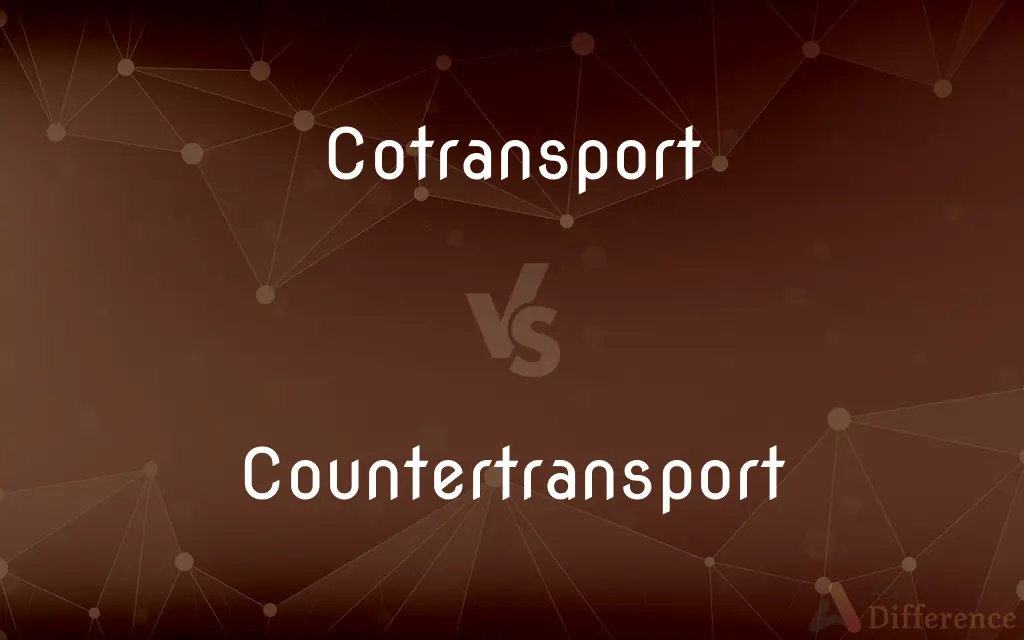Cotransport vs. Countertransport — What's the Difference?
By Tayyaba Rehman — Published on October 30, 2023
Cotransport is the simultaneous transport of two substances in the same direction across a membrane, while countertransport involves two substances moving in opposite directions.

Difference Between Cotransport and Countertransport
Table of Contents
ADVERTISEMENT
Key Differences
Cotransport and countertransport are mechanisms in cellular biology that concern the movement of molecules across cell membranes.
Cotransport refers to a process where two molecules are moved together in the same direction across a membrane, usually with the aid of a transport protein. On the other hand, countertransport is the mechanism wherein two molecules are transported across the same membrane but in opposite directions.
Both mechanisms are energy-efficient ways for cells to transport substances, but their directions and dynamics differ. In cotransport, often one molecule moves down its concentration gradient, providing energy for the movement of another molecule against its gradient.
In countertransport, while one molecule moves into the cell, another might move out, and vice versa. The balance between cotransport and countertransport is crucial for maintaining the cell's internal environment and ensuring its proper function.
Comparison Chart
Direction of Movement
Two substances move in the same direction.
Two substances move in opposite directions.
ADVERTISEMENT
Energy Utilization
Often uses the gradient of one molecule to transport another.
Uses the gradient of one molecule to transport another oppositely.
Relation with Transporters
Typically involves symporters.
Typically involves antiporters.
Functional Significance
Helps in absorbing nutrients like glucose in the intestines.
Important in processes like sodium-potassium pump in nerve cells.
Dependence on Gradient
One molecule typically moves down its gradient.
Each molecule moves against the other's gradient.
Compare with Definitions
Cotransport
The simultaneous movement of two molecules in one direction.
In the intestines, glucose absorption occurs through cotransport with sodium.
Countertransport
Transport facilitated by antiporters.
In cells, antiporters play a significant role in countertransport systems.
Cotransport
Transport wherein one molecule's gradient aids another's movement.
Sodium-driven cotransport helps in amino acid uptake.
Countertransport
Cellular mechanism involving the exchange of molecules.
Countertransport helps maintain cellular ion balance.
Cotransport
A cellular process facilitated by symporters.
Cotransport systems often rely on specific symporter proteins.
Countertransport
Movement wherein one molecule's gradient powers another's opposite movement.
The balance of calcium and hydrogen ions often involves countertransport.
Cotransport
A mechanism involving two substances crossing a membrane together.
Cotransport ensures efficient uptake of nutrients in many cells.
Countertransport
Opposite movement of substances to maintain cellular balance.
Countertransport is essential for pH regulation in cells.
Cotransport
Concurrent transport of molecules in identical directions.
Cotransport of water and solutes is crucial for kidney functions.
Countertransport
A process where two substances move in opposite directions across a membrane.
The sodium-potassium pump operates through countertransport mechanisms.
Cotransport
The simultaneous transport of two substances (across a biological membrane).
Countertransport
(biochemistry) The transport of two chemical species across a membrane in opposite directions
Cotransport
To transport two substances simultaneously (across a biological membrane).
Countertransport
To transport two chemical species across a membrane in opposite directions
Common Curiosities
What is the primary direction of movement in cotransport?
In cotransport, two substances move in the same direction across a membrane.
How does countertransport differ from cotransport in terms of direction?
In countertransport, two substances move in opposite directions across the membrane.
Why is cotransport crucial in the intestines?
Cotransport is vital in the intestines for the absorption of nutrients like glucose.
What is an example of a process that relies on countertransport?
The sodium-potassium pump in nerve cells is an example that relies on countertransport.
How does cotransport utilize energy gradients?
In cotransport, one molecule moving down its gradient can provide energy to transport another molecule against its gradient.
Can cotransport and countertransport occur in the same cell?
Yes, both mechanisms can operate in the same cell, catering to different cellular needs.
How does countertransport maintain cellular balance?
Countertransport exchanges ions or molecules, helping to maintain the balance of substances inside and outside the cell.
How does the sodium-potassium pump utilize countertransport?
The sodium-potassium pump expels three sodium ions out of the cell and takes in two potassium ions, exemplifying countertransport.
How is countertransport typically mediated at the cellular level?
Countertransport is typically mediated by antiporters.
Do cotransport and countertransport always require protein carriers?
Typically, yes. Most cotransport and countertransport processes are facilitated by specific proteins like symporters or antiporters.
Why are these transport mechanisms vital for cell survival?
They help maintain cellular environments, regulate pH, and ensure nutrient and ion balances essential for cell functions.
What type of protein typically facilitates cotransport?
Cotransport is typically facilitated by symporters.
Are these transport mechanisms passive?
Not necessarily. While they might utilize concentration gradients, they often involve active processes requiring energy.
Is cotransport always symport?
Generally, yes. Cotransport typically involves symporters that move two substances in the same direction.
Can countertransport help in pH regulation?
Yes, countertransport can exchange ions that play a role in maintaining and regulating cellular pH.
Share Your Discovery

Previous Comparison
Chow Mein vs. Hakka Noodles
Next Comparison
SSN vs. SSBNAuthor Spotlight
Written by
Tayyaba RehmanTayyaba Rehman is a distinguished writer, currently serving as a primary contributor to askdifference.com. As a researcher in semantics and etymology, Tayyaba's passion for the complexity of languages and their distinctions has found a perfect home on the platform. Tayyaba delves into the intricacies of language, distinguishing between commonly confused words and phrases, thereby providing clarity for readers worldwide.













































